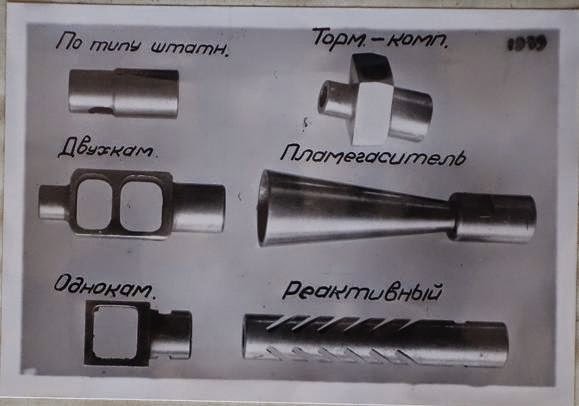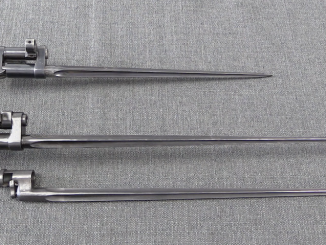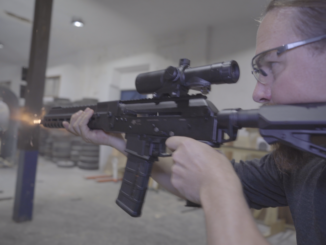In 1950, early in the days of AK development, there was some experimentation done with muzzle brakes, in an effort to reduce muzzle climb and improve accuracy (as well as full-auto controllability, I expect). From the Soviet Gun Archives blog, I found this photo of a half dozen different devices tested:

“The positive effect of the muzzle brake on the accuracy is at odds with the negative result of the sound wave hearing, which is greatly increased to unacceptable levels with most muzzle brakes.…The evaluation of the effect of the sound waves on hearing reveals that all muzzle brakes in the table result in a bothersome or painful sensation in the ears.”
I find it quite interesting that these experimental brakes as a group bear quite a lot of resemblance to the commercial brakes many shooters put on competition or “tactical” rifles today. In particular, I find it entertaining to consider that 1950s Red Army officials were more concerned about shooting comfort and hearing than modern competitors. Of course, this isn’t really a fair comparison; the Red Army was working as a group and not using hearing protection while modern sport and competitive shooters use very effective hearing protection and don’t do anything that requires cooperation or complex communication with other people while shooting. Today’s type of competition shooting simply doesn’t reveal the full consequences that the jarring concussion of modern “tactical” muzzle brakes would have in a more realistic situation.




Also, all of the devices (especially the cone-shaped and reactive ones) increased the OAL of the rifle. The AK was designed to be short overall to be easily handled in the confines of an APC, and be easily gotten through exit doors which are miniscule by even early Western standards. (Look at the rear doors of the BRDM and compare them to the ramp of an M59.)
The Red Army may have concluded that whatever gain they might have achieved with the muzzle devices wasn’t worth the aggravation those devices would cause the rest of the time by getting hung up on things.
cheers
eon
You’re talking about the Skladnoy variants of the Kalashnikovs..the Kalashnikov WAS NOT DESIGNED TO BE COMPACT…. THE AKS74U WAS
I remember that in the late-1950s/early-1960s a friend at college had a 12 ga. with a “cutts Compensator” installed and that while shooting it was not too bothersome to him it was excruciatingly painful to stand beside him in a duck blind. This leads me to believe that the Russian designers were concerned with damaging the hearing of their combat soldiers instead of with the comfort of their men. Being deaf is most certainly a hindrance to combat proficiency and capability. But the research is interesting and begs the question whether or not noise control in combat weapons has not come of age. I do know that a former Army SF has contacted me concerning this question within the past week so someone must be considering the possibilities of the technology.
For years I was a range officer (RO) at USPSA matches, standing right alongside shooters as they ran through the courses of fire. I always wore state of the art hearing protection, and being right handed was to the right and behind the shooters with my left side towards them, left hand holding the timer. I now have a severe hearing loss in my left ear. No proof of this, but I suspect it is from the open class guns with their compensators. Very effective compensators, but man they are loud standing off to the side.
When you talk about today’s consequences in a tactical situation you are spot on about the effects of muzzle brakes on hearing. Russia has always had an affinity for muzzle brakes over flash hiders as evident on their PPSh-41’s, AKM’s, AK-74’s, AK-12, A-545, AN-94, etc. Though most of the issued brakes are more on the tame side and do no reflect gases back towards the shooter, many of the aftermarket modifications found on Russian service rifles are the more aggressive, competition, style muzzle brakes that do have such jarring noise and blast characteristics that might disturb the shooter (though the AK-74 and older brakes do produce sideways concussion which does affect other teammates.)
After purchasing some of these newer, aftermarket, muzzle devices that are being more increasingly seen on Russian service rifles the Russian vendors have said that electronic hearing protection should be used with these in order to facilitate (while still protecting) a user’s hearing. This still does not address the increased concussion from the rifles. One of the other popular muzzle devices is the Bulgarian style “krinkov” four piece muzzle booster that reduces concussion while also acting as a flash hider (much the same as the Noveske Pig.) What I presume is that many of the units that are finding themselves in urban situations use these flash hiders more often while other untis in other situations end up using the muzzle brakes in more open and less constricted spaces. I suppose one of the more useful features of the AK is the ability to change muzzle devices without the use of any tools where a unit could change between flash hiders and muzzle brakes as the situation dictated.
“Russia has always had an affinity for muzzle brakes over flash hiders as evident on their PPSh-41′s, AKM’s, AK-74′s, AK-12, A-545, AN-94, etc.”
It is true for hand-held fire-arms, but machine gun were mainly equipped with conical flash-hidder, DShK machine gun feature muzzle brake, but DP machine gun (and its development), DS-39 machine gun, SG-43 machine gun, NSV machine gun, KPV (and KPVT) are equipped with conical flash-hidders
That’s an interesting observation. It seems that many of their machine guns do opt for flash hiders. The RPK-74, PKM, and the others you mentioned do use flash hiders. What I can guess is that those weapons were intended to be fired more often from a prone supported position where recoil and muzzle climb is less of a factor. Your comment about the NSV is interesting. There seem to be several configurations of the NSV where it has a conical flash hider as well as a muzzle brake, which seems to be the case for the KORD as well (the later models are produced with a muzzle brake exclusively I think.) I think this might be the case as well with the KPV as it is always attached to a vehicle of some kind, if not it’s little SG-43 style cart.
I don’t see the value of a muzzle brake at all!
All the lead I’m sending to the berm is to be consistent, and I don’t want to annoy my fellows on either side of me.
Properly-designed muzzle-brakes are useful on full-auto weapons, mainly if they are designed to vent gas upwards to reduce climb on full-auto.
Keep in mind that the primary intended fire mode for the Avtomat Kalashnikov obrazets 1947 was full-auto, at ranges from 0 to 150 meters. The idea being to use the Avtomat much like the older PPSh-41 SMG, to deliver roughly-aimed suppressive fire en masse, as part of the assault tactic of overwhelming the enemy with firepower. (The contemporaneous American concept of the “sustained firescreen”, born of CONARC’s Project SALVO, was very similar, albeit mainly used on defense rather than offense.)
Seen in this light, a muzzle brake designed not so much to reduce recoil as to negate muzzle climb makes excellent sense. The AK-74 muzzle compensator (for that is what it fundamentally is), was designed with exactly this purpose in mind.
Muzzle brakes on rifles intended primarily for semi-auto fire are mainly an affectation. For that matter, with very few exceptions, flash suppressors on rifle-caliber weapons other than full-auto ones are, as well. I have fired Ruger Mini-14s and Colt AR-15s side-by-side in daylight and darkness, and noticed very little difference in flash, especially with equal barrel lengths.
Remember that the usual cause of muzzle flash is unburned powder igniting on contact with the outer air after the bullet leaves the muzzle. It’s nature’s way of telling you your barrel is too short for maximum efficiency with the propellant in your ammunition.
If the propellant and barrel length are properly “matched” as per the propellant burning curve, there should be little or no discernible muzzle flash, with or without a flash suppressor.
With the Ruger, muzzle flash literally depends on which brand and/or loading of 5.56 x 45mm you use in it. Generally, military ball generates more flash than sporting ammunition, solely due to the differences in propellant burning.
It’s why varmint hunters and benchrest shooters don’t generally have such gadgetry on the muzzles of their “long arms”. About the best thing that can be said of a flash suppressor, or a muzzle brake on a non-autofire weapon, assuming the proper loads are in the rifle, is that it protects the actual muzzle crown from damage, which is detrimental to accuracy.
cheers
eon
Eon: “Generally, military ball generates more flash than sporting ammunition, solely due to the differences in propellant burning.”
Military ammo almost always has flash suppressants added to the powder, thereby generating much less flash than commercial ammo.
Varmint hunters don’t typically have a requirement for rapid shooting, the cartridges are usually small, and the rifles and the associated equipment- scope, bipod- are usually heavy. That’s why one rarely sees a muzzle device on a varmint rifle. Properly installed, a muzzle device will have little effect on accuracy.
“Keep in mind that the primary intended fire mode for the Avtomat Kalashnikov obrazets 1947 was full-auto, at ranges from 0 to 150 meters. The idea being to use the Avtomat much like the older PPSh-41 SMG, to deliver roughly-aimed suppressive fire en masse, as part of the assault tactic of overwhelming the enemy with firepower.”
Hence Simonov self-loading carbine (SKS) designed for more aimed fire have not muzzle brake.
1. Original AK 47 didn’t have any form of muzzle device either.
2. SKS also has a folding bayonet, which makes muzzle devices difficult.
You have no real knowledge on the matter… every point of yours is absolute BS
The value of a brake is in “practical” shooting like 3-gun, USPSA, IPSC and so on where time is important targets are typically not tiny. It really really really speeds up your followup shots (you’re typically putting 2 rds on a target) since a well-tuned and well-balanced AR15 barely moves on firing.
Basically nothing can keep up with a tuned AR15, no matter how much work you do to a SIG 55x, AK or whatever.
False. ANY properly tuned rifle can keep up with an AR hell the FG42 built in wartime using the much much much more powerful 7.92x57mm mausercround BARELY MOVES ON FULL AUTO, is made better is more consistent and can out perform the highly highly overrated AR platform. The AK can just as ccx easily
“I don’t see the value of a muzzle brake at all!”
Similar conclusion was done by Red Army when they tested prototype of 76.2mm gun F-22 with muzzle brake. The main concern was that when field gun was fired it make cloud of dust from ground, possibly pointing to enemy where the gun is. However when the Soviet Army start fighting with Wehrmacht equipped with howitzers with muzzlebrakes, they starts to field guns with muzzle-brake (see: 76mm Grabin ZiS-3, 152mm howitzer D-1)
A War Story from my wild youth. I was commanding the Second Platoon of A Coy, 1st Bn RAR in a running shoot out with a ZANLA penetration group in southern Matabeleland. I was busy screaming into the radio when my Batman/Runner/Bodyguard Rifleman Zulu Darlington who was to my right rear brought his FAL up and touched off a round with his muzzle about six inches to the right of my head. The world was suddenly silent and my vision was full of bright flashing stars. I dropped the radios’ handset, and damn near fell to my knees. I had one of those split second moments where you think, “Damn, I’m dead. Gosh, I thought it would hurt more.” When I recovered I asked Zulu words to the effect of “What in the everloving Hell did you do that for?!?!” He just grinned and pointed to a ZANLA Terr (Now deceased.)about five yards to my left front. All was forgiven, but I couldn’t hear from my right ear for about 24 hours. The Russkies made the right choice.
How that baddie got there is probably not by sprinting. Men cannot outrun bullets.
One item which was not mentioned so far in discussion is use of blank firing attachment (BFA). On rifles with muzzle breaks or suppressors it is rather complicated.
Case in point is Vz.58; its BFA was trivial affair. Not so simple with M16.
A sort of philosophical question which had bothered me for some time:
What are the flash-hiders supposed to do:
1. Conceal the shooter as much as possible from the enemy?
2. Protect the eyes of the shooter (especially at night)?
3. Both?
Regards,
ANDRZEJ
Flash hiders are for concealment from the enemy – muzzle flashes give you something to shoot at when the shooter isn’t visible. They might also preserve some night vision.
They also redirect the gases upwards and to the sides, so if you’re shooting from prone over sand or loose dirt you don’t blow a big cloud of dust into your field of view with each shot – so that also makes you less conspicuous to the enemy.
I had an opportunity to shoot Mosin 1944 and AK.
That some one should consider placing muzzle break ON AK?
Regards, A.
Thank You,
Andrzej